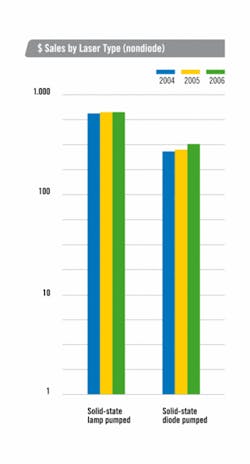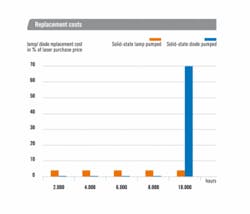By Neil S. Ball, Directed Light, and Matthias Stein, Heraeus Noblelight
Although it provides the lifeblood for the majority of industrial solid-state lasers, the humble CW lamp or flashlamp is rarely afforded the importance it deserves. While the spotlight of attention has been on diode-pumped lasers for some years, their lamp-pumped counterparts quietly outsell diode-pumped systems year after year, as the figures from a recent marketplace survey show.
This does not mean that the industry has got it all wrong in recent years. Diode-pumped systems do offer clear advantages in many lower-power applications, first and foremost lifetime and stability. However, understanding the capabilities of lamp-pumped lasers and their development might help to make the right system choice for the future depending on application needs.
Many readers will vividly remember the days when the lifetime of lamps in lasers was measured in days or, if you were lucky, in weeks. If you are working with or designing lamp-pumped lasers today, you will immediately notice the progress that has been made in recent years. Increasing lifetime by several hundred percent in just a few years is not what one would expect from a ¿mature¿ technology. Indeed, there is a lot of research and development going on in some of the companies making laser lamps.
The example of a Heraeus Noblelight CW lamp for one and the same automotive application shows the difference. About 10 years ago, the lamp lasted for 250 hours, which was considered a good lifetime at the time. Then, significant progress was made by changing the cathode material, and lifetime doubled to 500 hours. Today, with further improvements, the lamp lasts for more than 2000 hours under identical operating parameters.Similar progress has been recorded at Heraeus Noblelight in flashlamps. The NextGen flashlamp series that was introduced in 2006 pushes typical lifetime from 0.5 million shots to 3 million shots under harsh long-pulse, high-transfer conditions.
Improvements in lamp design
As early as 1982, an article on pulsed-laser lamps stated: "Indeed, the science behind this vital component has shown little progress for about 10 years." Shortly afterward, the first big wave of improvement took place: optimizing cathode material and geometry.
To understand why this has considerable impact on lamp performance, let's look at the typical failure mechanism of a laser lamp. The temperature cycle of the cathode, which reaches temperatures of more than 2000°C and temperature gradients of up to 10,000 K/mm leads to sputtering of cathode material onto the wall of the lamp. Eventually, the tip of the cathode may crack or break up. This leads to blackening of the internal wall of the lamp and reduces the light output from the lamp and consequently the laser output. If the lamp is not replaced, blackening increases further.
Eventually a point is reached when the lamp fails due to its wall absorbing a great deal of energy, resulting in failure of the quartz material that forms its body. Heraeus addressed this problem in the 1980s with the HiCharge cathode design, which incorporates a heat choke. This design allowed control over the electron-emitting surface temperature and reduced temperature variations. A second part of the HiCharge cathode technology was a new processing technique for the cathode material. The result of this development work by John Littlechild and his colleagues at Heraeus was a doubling of lifetime for many lamp types.
Heraeus again is working on new ways to further push the limits of lamp performance. This time, the focus is on the manufacturing process of the lamps. For years, laser lamps have been basically handmade due to the complexity of the processes involved. Skilled lamp makers could achieve very good quality, but by automating and optimizing key steps in the production process, further progress became possible.
First of all, lamp-to-lamp tolerances become smaller, which means more stable performance for the lamp user. Especially in industrial environments, this is a key benefit that has been demanded by customers.
Second, the process on the Heraeus Autoline makes a stronger seal possible, which in turn reduces the likelihood of lamp failure under high-power conditions. And third, Heraeus introduced a new pumping process that leads to an even purer gas fill, which again increases lamp lifetime.
All these improvements together lead to another increase in lifetime to the levels described above. And they demonstrate the capabilities of lamp technology to deliver performance improvements that keep lamp-pumped lasers competitive.
But not only lifetime has gone up. New materials and production technologies have also enabled more powerful lamps and more powerful laser systems. While the average power of an industrial lamp-pumped laser was 20 W in the 1970s and 500 W in the early 1990s, it is 6000 W today.
Future of lamp-pumped lasers
more important than power, flashlamp-pumped lasers are leading in all applications that require quick bursts of high energy. First and foremost, there is drilling, high-power cutting, and welding.
But, in addition, lamp-pumped CW lasers continue to thrive in areas where precision and robustness are important. One example is diamond cutting. Lamp-pumped lasers are working reliably in this application every day under harsh conditions in India and Africa. Due to the high price of the raw diamonds, high stability of the lamp output is required to avoid any unnecessary waste. Here the Heraeus lamps made on the automated manufacturing line with narrow tolerances have clearly outperformed other lamp types.
Besides process-related benefits, there are economical advantages of a lamp-pumped system. Lamps are more temperature-tolerant than diodes, making simpler cooling possible. Also the replacement costs for lamps are lower than for diode bars. A leading laser system manufacturer estimates the service and lamp costs for a lamp-pumped laser to be approximately 3% of the laser purchase price in every 2000-hour maintenance interval. In comparison, the maintenance cycle for a diode-pumped laser may be more than 10,000 hours, but then, the replacement of the diodes may cost up to 80% of the laser purchase price.
Progress remains a part of daily life in the lamp-pumped laser industry, and lamp companies that continue to invest in R&D and modern manufacturing will continue to drive this progress.




